Robinia Pseudoacacia

Robinia pseudoacacia: The Versatile and Resilient Black Locust Tree
Robinia pseudoacacia (commonly known as black locust) is a remarkable tree native to eastern North America and belongs to the extensive pea family, Fabaceae. This hardy species has several distinctive characteristics, making it both beloved and occasionally problematic in various parts of the world.
Distinctive Features
The black locust tree (Robinia pseudoacacia) is easily recognizable by several distinct characteristics that contribute to its unique identity and aesthetic appeal:
- Leaves: The tree features long oval pinnate leaflets arranged in an alternate pattern along the stem. Each compound leaf typically contains 7-19 leaflets, which are oval shaped with smooth margins. At the base of each leaf stalk, small, sharp spines or stipules provide a slight defense mechanism against herbivores.
- Flowers: One of the most striking features of the black locust is its fragrant flowers. These flowers are usually white or sometimes yellowish, forming drooping clusters known as racemes. Blooming in late spring to early summer, they emit a sweet aroma that is highly attractive to bees and other pollinators. This makes the black locust an important plant for honey production, with its blossoms yielding a high quantity of nectar.
- Fruit: Following the flowering period, the tree produces a fruit called a legume. These legumes are thin, flat pods, typically 2-4 inches long and contain 4-10 seeds. The pods turn from green to brown as they mature and eventually split open to release the seeds.
- Height and Trunk: Black locust trees can grow impressively tall, reaching up to 100 feet in height. The trunk can attain a diameter of up to three feet, giving the tree a robust and sturdy appearance. This makes it a significant presence in any landscape where it grows.
- Bark: The bark of the black locust is another distinctive feature. It is rough and deeply furrowed, with a brownish-gray color. The bark's rugged texture adds a visual contrast to the smoothness of the leaves and the delicate appearance of the flowers.
- Roots: The root system of the black locust is extensive and aggressive, allowing it to anchor firmly in the soil and thrive in a variety of environments. This robust root system also contributes to its ability to fix nitrogen in the soil, improving soil fertility and benefiting surrounding vegetation.
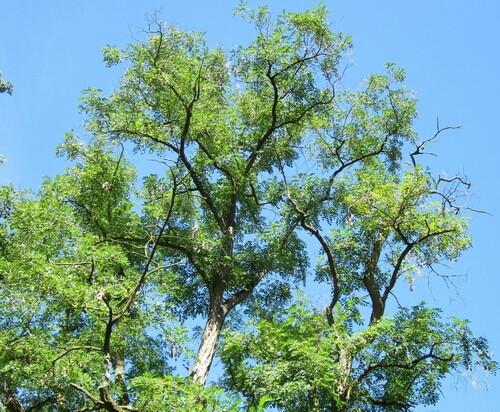
A Group of Black Locust Trees - Image by Wikimedia Images on Pixabay
These distinctive features not only make Robinia pseudoacacia visually appealing but also contribute to its ecological and economic significance. Its rapid growth, attractive flowers, and durable wood have made it a popular choice for various uses, from ornamental planting to practical applications in construction and soil improvement.
Historical Significance
Robinia pseudoacacia boasts a rich historical significance that extends beyond its native range in eastern North America. Its introduction and proliferation in Europe during the 17th century have left an enduring legacy that continues to impact both natural and human environments.
Introduction to Europe
The black locust was first introduced to Europe in the early 1600s. Jean Robin, a botanist serving the French kings Henry III, Henry IV, and Louis XIII, is credited with planting the first black locust seeds in Europe. In 1601, Robin planted the seeds in one of his gardens, marking the beginning of the tree's European journey.
Linnaeus and the Robinia Genus
The genus Robinia was named by Carl Linnaeus, a renowned Swedish botanist, in honor of Jean Robin and his son Vespasien Robin, who were instrumental in the tree's introduction to Europe. Linnaeus's classification highlighted the significance of the tree and its discoverers in botanical history.
Historic Tree in Paris
One of the original black locust trees planted by Jean Robin still stands today in the Square René Viviani in Paris, France. This tree is estimated to be about 400 years old, making it one of the oldest and most famous black locusts in Europe. It serves as a living testament to the tree's resilience and historical importance.
Economic and Environmental Impact
During its early years in Europe, Robinia pseudoacacia was widely cultivated for various reasons. Its rapid growth and ability to thrive in poor soil made it an ideal candidate for afforestation and erosion control projects. The tree's high-quality wood, which is resistant to rot and pests, quickly became valuable as building material for fence posts, furniture, and small watercraft. This economic value contributed to its widespread planting and cultivation across the continent.
Role in Afforestation
In the 18th and 19th centuries, black locusts played a crucial role in afforestation efforts across Europe. Its fast growth and ability to improve soil fertility through nitrogen fixation made it a popular choice for reforestation projects, particularly in areas suffering from soil degradation and deforestation.
Controversial Status as an Invasive Species
Despite its many benefits, Robinia pseudoacacia has also gained a reputation as an invasive species in many parts of Europe. Its ability to spread quickly and outcompete native flora has led to ecological concerns. However, its historical and economic contributions continue to make it a subject of both appreciation and contention.
The black locust's journey from North America to Europe and its subsequent impact on both the environment and human industries underscore its historical significance. Its legacy is a blend of botanical achievement, economic utility, and ecological challenge, reflecting the complex relationship humans have with introduced species.
Ecological and Economic Impact
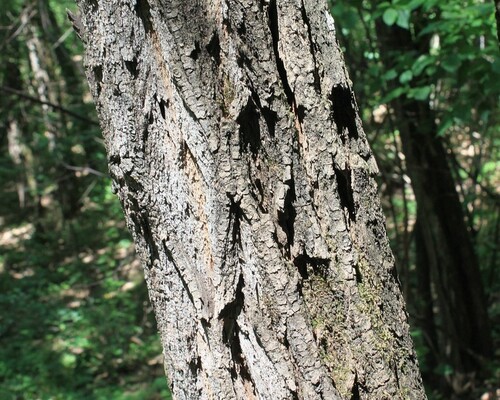
The Bark of Robinia Pseudoacacia - Image by Byrev on Pixabay
Robinia pseudoacacia has left an indelible mark on both ecosystems and economies across the globe. Its unique properties and diverse applications have positioned it as a valuable resource despite the challenges it sometimes poses as an invasive species.
Wood Quality and Uses
The black locust is highly prized for its wood, which is known for its exceptional durability and resistance to rot and pests. This makes it an ideal material for constructing outdoor structures such as fences, decking, and furniture. Its wood is also used for small watercraft and flooring, where its robustness and longevity are highly valued. The high calorific value of black locust wood makes it an excellent source of firewood and biomass energy.
Erosion Control
One of the critical ecological benefits of Robinia pseudoacacia is its ability to control soil erosion. Its extensive root system stabilizes soil on slopes and in areas prone to erosion, making it a vital component of reforestation and land reclamation projects. This capability has been utilized extensively in both North America and Europe to prevent soil degradation and restore damaged landscapes.
Nitrogen Fixation
Robinia pseudoacacia plays a significant role in enhancing soil fertility through nitrogen fixation. The tree's roots contain nodules with nitrogen-fixing bacteria, which convert atmospheric nitrogen into a form that plants can use. This natural fertilization process improves soil health, benefiting surrounding vegetation and promoting biodiversity. It is particularly beneficial in degraded or nutrient-poor soils, where it can kickstart ecological recovery.
Habitat and Biodiversity
The tree's flowers are a crucial source of nectar for pollinators, especially bees. The aromatic blooms attract a variety of insects, making Robinia pseudoacacia a valuable component of pollinator-friendly habitats. The high nectar yield supports honey production, benefiting both wild and managed bee populations. This, in turn, supports broader biodiversity by ensuring the pollination of various plant species.
Invasive Species Challenges
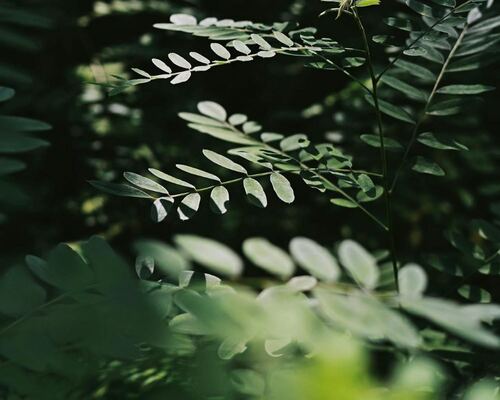
Black Locust Tree Leaves - Image by Darya Grey_Owl
Despite its benefits, Robinia pseudoacacia is classified as an invasive species in many regions, particularly in Europe and parts of Asia. Its aggressive growth and ability to thrive in diverse conditions allow it to outcompete native flora, disrupting local ecosystems. Management of its spread requires careful planning and intervention to balance its positive attributes with its potential to dominate landscapes.
Economic Contributions
The economic impact of Robinia pseudoacacia extends beyond its wood. Its role in preventing soil erosion and improving soil fertility has long-term economic benefits for agriculture and forestry. By enhancing land productivity and reducing the need for chemical fertilizers, black locust supports sustainable agricultural practices. Additionally, its contribution to honey production adds economic value to apiculture industries.
Carbon Sequestration
As a fast-growing tree, Robinia pseudoacacia also contributes to carbon sequestration, capturing atmospheric carbon dioxide and storing it in its biomass. This makes it a valuable species in efforts to mitigate climate change, particularly in reforestation and afforestation projects aimed at increasing carbon sinks.
Robinia pseudoacacia is a tree of significant ecological and economic importance. Its durable wood, soil-stabilizing roots, nitrogen-fixing abilities, and role in supporting pollinators make it an asset in various environmental and economic contexts. However, its potential to become invasive requires careful management to ensure that its benefits are maximized while minimizing ecological disruption.
A Personal Favorite
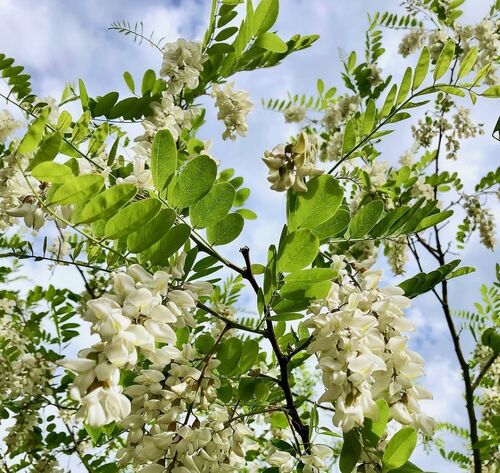
Leaves and Blooms of Robinia Pseudoacacia - Image by modul6ollis on Pixabay
The black locust tree (Robinia pseudoacacia) holds a special place in the heart of Jean Claude Rochat, the founder of Arborist Now. His admiration for this versatile tree is rooted in its remarkable attributes and its contributions to his family's homestead in Switzerland.
Versatility in Use
Jean Claude Rochat and his family have found numerous ways to utilize the black locust tree, showcasing its versatility. The tree's highly durable wood is employed in various construction projects around their homestead. From building sturdy fences and garden structures to crafting beautiful, long-lasting furniture, the black locust’s wood proves invaluable for its resistance to rot and pests.
Enhancing Soil Fertility
The nitrogen-fixing ability of Robinia pseudoacacia has been a boon for the Rochat family’s agricultural endeavors. By planting black locust trees, they have improved soil fertility naturally, reducing the need for chemical fertilizers. This sustainable approach to soil management not only benefits their crops but also supports the overall health of the local ecosystem.
Supporting Pollinators
The aromatic flowers of the black locust are a magnet for pollinators, particularly bees. Jean Claude Rochat’s homestead has seen an increase in bee activity during the blooming season, leading to higher honey production. The presence of these pollinators also enhances the pollination of other plants in their gardens and orchards, contributing to more bountiful harvests.
Erosion Control and Land Management
The extensive root system of the black locust plays a crucial role in preventing soil erosion on the Rochat family’s property, particularly on slopes and other vulnerable areas. By stabilizing the soil, these trees help maintain the integrity of the landscape and protect valuable agricultural land from degradation.
Aesthetic and Historical Appreciation
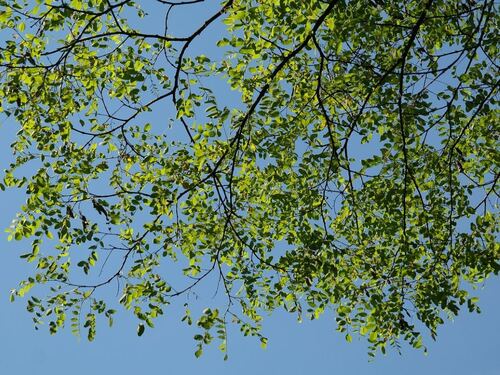
Branches and Leaves of Robinia Pseudoacacia - Image by Hans from Pixabay
Beyond its practical uses, Jean Claude Rochat appreciates the black locust for its historical significance and natural beauty. The rugged bark, graceful leaves, and fragrant flowers add a unique charm to the homestead, creating a visually appealing and inviting environment. Additionally, the historical connection of the black locust to Jean Robin and its legacy in Europe resonates with Rochat’s deep respect for botanical history.
Environmental Stewardship
Jean Claude Rochat’s affinity for Robinia pseudoacacia aligns with his commitment to environmental stewardship. By integrating this tree into his homestead’s ecosystem, he demonstrates a holistic approach to land management that emphasizes sustainability, biodiversity, and ecological balance. The black locust’s contributions to carbon sequestration and habitat creation further support Rochat’s environmental goals.
The black locust tree's remarkable qualities have made it a beloved element of Jean Claude Rochat's homestead in Switzerland. Its practical applications, ecological benefits, and historical significance reflect the tree’s enduring value and Rochat’s dedication to sustainable and thoughtful land management. Through his appreciation and utilization of Robinia pseudoacacia, Rochat continues to highlight the importance of integrating nature’s resources into everyday life.
Do you have black locust or other native trees on your property? Contact Arborist Now for advice on how to make the most of your native greenery.
Originally posted on August 21, 2018





